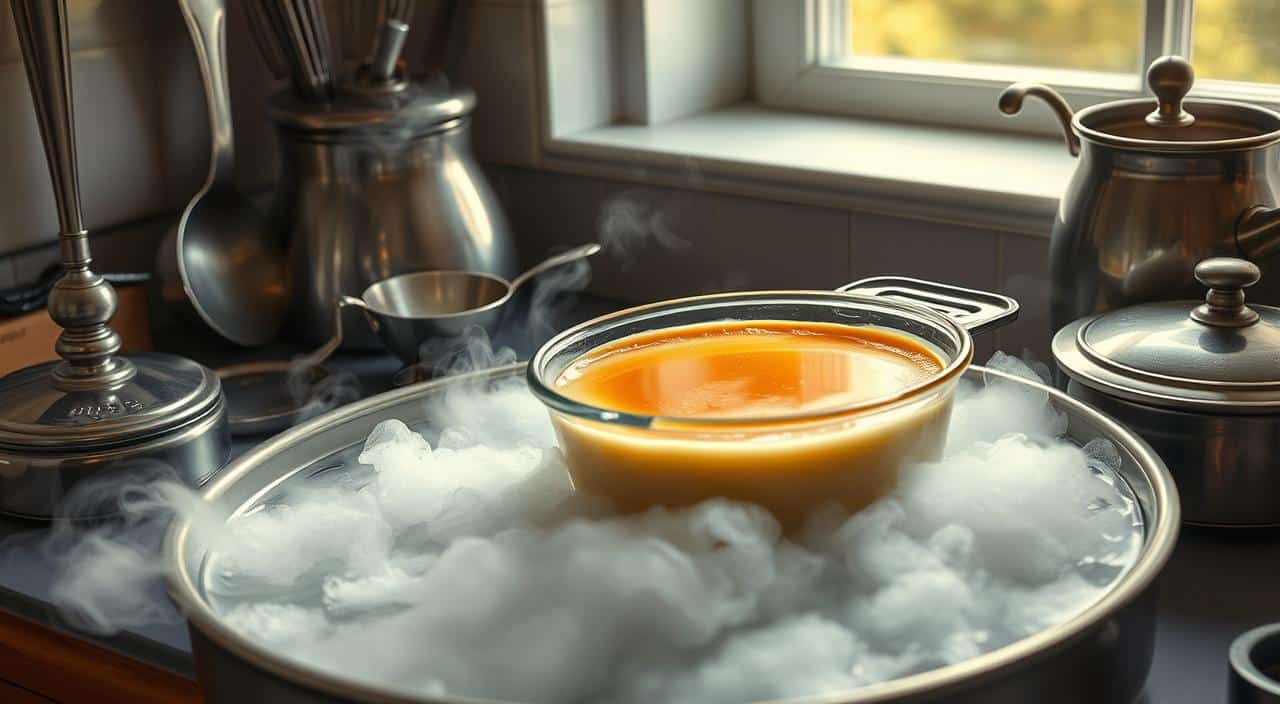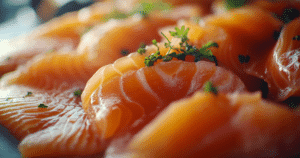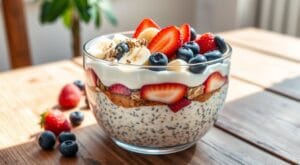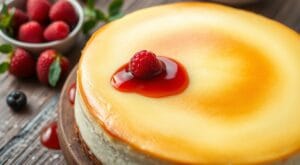Jump to:
Estimated reading time: 16 minutes
Table of contents
Why is creme brulee cooked in a water bath? Crème brûlée is a beloved French dessert. It’s famous for its creamy custard and caramelized sugar. The secret to this perfect mix is the water bath cooking method.
By baking in a water bath, the custard cooks evenly. This prevents it from becoming too hard or curdling. The result is a silky texture that’s essential for crème brûlée.
Why is creme brulee cooked in a water bath? Key Takeaways
- The water bath method ensures even and gentle cooking of the custard, preventing curdling and producing a beautifully set texture.
- Baking the custard in a water bath helps maintain a consistent temperature throughout the cooking process, which is crucial for preventing overcooking and maintaining the smooth, creamy consistency.
- The water bath technique helps protect the delicate custard from direct heat, allowing the eggs to cook gently and resulting in a silky-smooth final product.
- Using a water bath is an essential step in the preparation of crème brûlée, as it helps create the signature custard base that is the foundation of this classic French dessert.
- Mastering the water bath method is key to achieving the perfect crème brûlée with a custard that is perfectly cooked and has a velvety texture.
Introduction
Crème brûlée is a beloved French custard dessert. It has won the hearts of many with its creamy base and caramelized sugar top. The ingredients are simple: cream, eggs, sugar, and vanilla. But the secret to its perfect texture is the water bath (or bain-marie) during baking.
The baked custard technique, or “water bath” method, is key. It makes the custard smooth and velvety. This prevents it from becoming too hard or curdling. By placing the ramekins in a hot water bath, the custard cooks evenly. This keeps it moist and just right.
We’ll explore the science behind the water bath method. We’ll also give a step-by-step guide on how to use it. This will help you make the best crème brûlée ever.
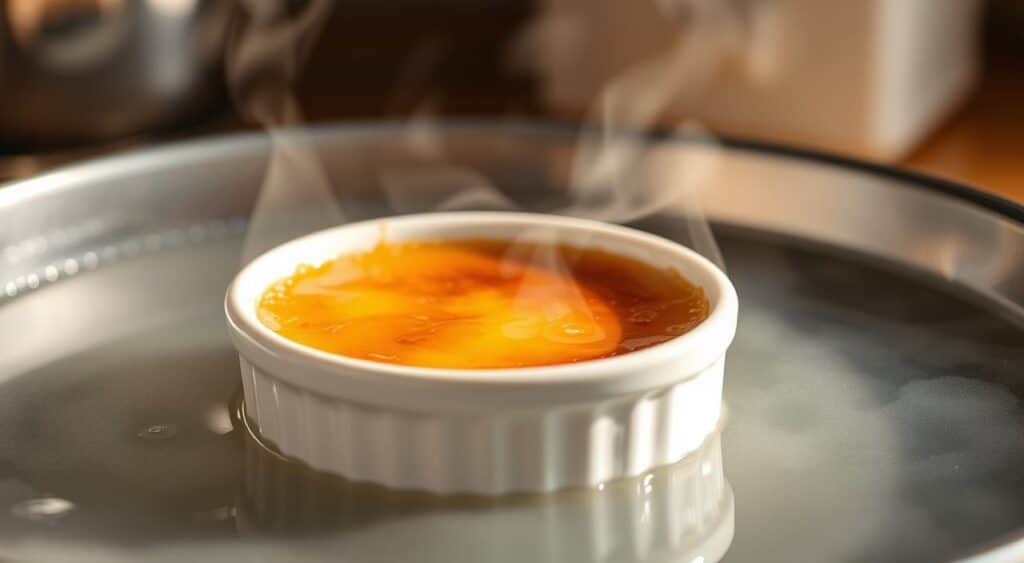
“The secret to a perfect crème brûlée lies in the water bath – it’s the key to achieving that luscious, silky-smooth custard texture.”
The Science Behind the Water Bath for Crème Brûlée
The water bath, or bain-marie, is key for perfect crème brûlée. It cooks the custard gently, making it silky-smooth. This method ensures even heat and prevents overcooking.
Why is creme brulee cooked in a water bath? How the Water Bath Helps Even Cooking
The water around the ramekins cooks the custard evenly. This even heat makes the custard creamy and consistent. It cooks without hot spots, giving a smooth texture.
Why is creme brulee cooked in a water bath? Preventing Overcooking with Gentle Heat
Crème brûlée is delicate and can become grainy if overcooked. The water bath’s gentle heat prevents this. It keeps the custard creamy and smooth, preserving its texture.
Why is creme brulee cooked in a water bath? Maintaining the Smooth Custard Texture
The water bath’s even heat is vital for a silky texture. It controls the temperature and prevents overcooking. This way, the custard becomes rich and velvety, melting in your mouth.
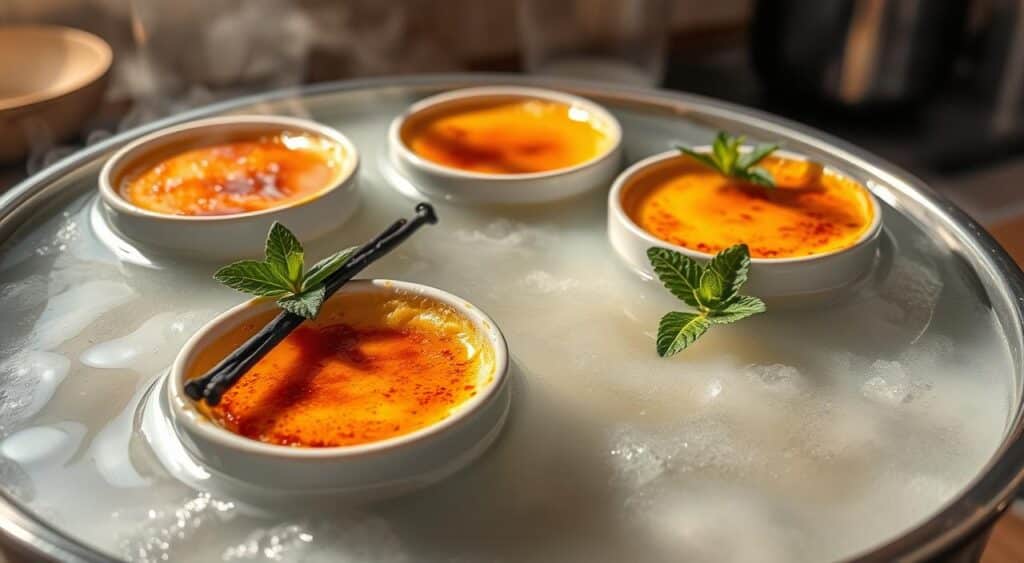
Why Temperature Control is Crucial for Crème Brûlée
Precise temperature control is key to making the perfect crème brûlée. The custard base, made mostly of egg yolks, can curdle or overcook with high heat. The water bath method keeps the temperature steady, ensuring a smooth bake.
Why is creme brulee cooked in a water bath? The Role of Consistent Heat Distribution
The water bath method uses hot water to surround the custard-filled ramekins. This creates a gentle, even heat. This even heat distribution prevents the eggs from contracting and causing a grainy texture.
Why is creme brulee cooked in a water bath? How a Water Bath Protects Delicate Custard
The water bath acts as a shield, protecting the custard from harsh heat. It keeps the custard smooth and creamy, avoiding curdling. The water bath maintains a steady temperature, around 176°F (80°C), for a perfect bake.
Why is creme brulee cooked in a water bath? Preventing Egg Curdling in the Custard
Egg yolks are crucial in the custard and are very sensitive to heat. Direct, intense heat can cause the eggs to contract, leading to a grainy texture. The water bath’s gentle heat prevents this, ensuring a smooth custard every time.
“The water in the water bath for baking crème brûlée never reaches a temperature higher than 212°F (100°C), slowing down the cooking process for delicate desserts.”

How to Set Up a Water Bath for Crème Brûlée
Setting up the water bath, or bain-marie, is key for a perfect crème brûlée. It ensures even cooking and keeps the custard dessert from getting too hot or curdling.
Choosing the Right Baking Dish and Tray
First, pick a baking dish or tray that fits your ramekins well. It should be big enough for even water distribution. A deep, oven-safe dish or roasting pan works best.
How Much Water Should You Add?
Slowly add water to the tray, filling it to about 3/4 of the ramekins’ height. This keeps the custards warm without water getting into the delicate custard.
Ensuring Even Water Distribution Around the Ramekins
Place the ramekins evenly in the tray. Keep the water level consistent during baking. This ensures even heat and a smooth, creamy texture in your crème brûlée.
“The water bath is essential for ensuring a perfect crème brûlée. It helps the custard cook evenly and prevents it from overcooking or curdling.”
Common Mistakes When Using a Water Bath for Crème Brûlée
Making a perfect crème brûlée needs careful attention, especially with the water bath method. This method is key for a creamy custard. But, some common mistakes can mess up the whole process.
Adding Too Much or Too Little Water
It’s important to get the water level just right. Too much water can make the ramekins float, leading to uneven heat and water getting into the custard. On the other hand, too little water can dry out the bath, causing the custard to overcook or become grainy.
Water Leaking into the Custard
Water getting into the custard is a big problem. It can ruin the custard’s texture, making it watery and unappetizing. To avoid this, make sure the water bath is set up right and seal the ramekins well.
Overheating or Underheating Issues
Keeping the water at the right temperature is crucial. Too hot can cause the custard to curdle, while too cold can make it jiggly. It’s important to control the temperature carefully to get the custard just right.
| Common Mistake | Potential Issue | Solution |
|---|---|---|
| Adding too much water | Ramekins floating, uneven heat distribution, water seepage | Use the right amount of water to just reach the bottom of the ramekins |
| Adding too little water | Water bath drying out, custard overcooking, grainy texture | Maintain a consistent water level throughout the baking process |
| Overheating the water bath | Custard curdling | Monitor and adjust the oven temperature to maintain the optimal water temperature |
| Underheating the water bath | Underdone, jiggly custard | Ensure the water bath is hot enough to gently cook the custard |
By avoiding these mistakes and focusing on the water level and temperature, you can make a great crème brûlée. It will have a smooth custard and a perfectly caramelized top.
Can You Make Crème Brûlée Without a Water Bath?
While the water bath method is the top choice for making crème brûlée, you can still make it without it. But, skipping the water bath brings big risks and challenges.
Risks of Skipping the Water Bath Method
Without the water bath, the custard can easily overcook, curdle, or get a grainy texture. The water bath keeps the custard smooth. Without it, the dessert’s quality might suffer.
Alternatives to Using a Water Bath
- Baking in a water-filled roasting pan can be a good substitute. But, you must watch the water level closely.
- Using a low-temperature oven, around 200°F (93°C), can also work. You might need to adjust the cooking time.
Achieving Similar Results Without a Water Bath
These alternatives can give you results close to the water bath. But, they might not give the same smooth, creamy texture as a perfect crème brûlée. The water bath is still the best way to get a flawless custard dessert.
| Preparation Method | Cooking Time | Texture Consistency | Ease of Execution |
|---|---|---|---|
| Water Bath | 30 minutes | Silky-smooth | Moderate |
| Baking in Water-Filled Pan | 35 minutes | Slightly grainy | Challenging |
| Low-Temperature Oven | 40 minutes | Moderately smooth | Easier |
Variations of Water Bath Cooking for Custards
The water bath method isn’t just for crème brûlée. It works for many custard desserts. This method ensures custards cook evenly without curdling.
Using the Water Bath for Other Desserts
Adapting the water bath for other recipes needs careful thought. Consider the dish size and cooking times. For instance, it’s great for baking, crème caramel, or cheesecakes, making them creamy.
Adapting the Method for Different Custard Types
The water bath is also good for panna cotta or flan. It prevents curdling and ensures a smooth texture.
Benefits of Using a Bain-Marie in Other Recipes
The bain-marie is not just for custards. It’s perfect for melting chocolate or heating sauces. It keeps food warm without scorching.
| Cooking Method | Ideal for | Temperature Range |
|---|---|---|
| Water Bath (Bain-Marie) | Custards, Flans, Cheesecakes | 175°F to 185°F (79°C to 85°C) |
| Bain-Marie (Double Boiler) | Melting Chocolate, Warming Sauces | 120°F to 160°F (49°C to 71°C) |
Learning about water bath and bain-marie cooking opens up new possibilities. Home cooks can make a variety of custard-based desserts and more.
“The water bath is an essential tool for creating silky-smooth custards and delicate desserts. It’s a game-changer for home bakers who want to achieve professional-level results.” – Chef Emily, Pastry Chef Online
How to Avoid Water Bath Disasters
The water bath method is key for perfect crème brûlée. But, there are a few common problems to watch out for. One issue is water seeping into the custard, ruining its smooth texture and making it watery.
Tips to Prevent Water Seeping into Custard
To stop water from getting into the custards, cover the ramekins with foil or parchment paper. Be careful when moving the tray to the oven. Any sudden moves can splash water into the custards.
How to Handle Overfilled Water Baths
Too much water in the bath can splash into the custards. Keep an eye on the water level and add more as needed. Make sure the water is about halfway up the ramekins.
Managing Water Temperature Throughout Cooking
It’s important to keep the water at a steady, gentle simmer. This ensures the custard cooks evenly. Avoid letting the water boil, as it can overcook the custard and make it grainy.
Following these tips will help you avoid common mistakes. This way, your crème brûlée will come out silky-smooth every time. Mastering the water bath is essential for making perfect custard desserts.
“The water bath is the secret to a truly exceptional crème brûlée – it’s the difference between a custard that’s smooth and creamy versus one that’s grainy or watery.”
Storing and Reheating Crème Brûlée Cooked in a Water Bath
Crème brûlée cooked in a water bath can be stored and reheated carefully. After baking, chill the refrigerating custard in the fridge until set, which takes at least 4 hours or up to 2 days. To serve, gently reheating creme brulee by placing ramekins in warm water or a low-temperature oven.
Be careful not to overcook or dry out the custard consistency after storage. This can ruin its smooth texture. With proper storage and reheating, crème brûlée can be enjoyed perfectly, even days after making.
Refrigerating Custard Without Affecting Texture
Chill the freshly baked crème brûlée in the fridge until set. This takes at least 4 hours or up to 2 days. Cooling slowly helps the custard firm up without becoming rubbery or grainy.
Reheating Methods for Crème Brûlée
When ready to serve, gently reheat the chilled crème brûlée. This keeps its silky-smooth consistency. The best methods are:
- Placing ramekins in a warm water bath, keeping the water low until the custard is just warm.
- Using a low-temperature oven, around 200°F (93°C), to slowly reheat the custards without overheating.
Maintaining the Consistency of the Custard After Storage
To enjoy crème brûlée even after storage, reheat it carefully. Avoid high heat or long cooking times to prevent drying out or curdling. Gently warming the chilled custards helps keep the silky-smooth texture of perfect crème brûlée.
| Storage Time | Recommended Reheating Method | Ideal Custard Texture |
|---|---|---|
| Up to 2 days | Warm water bath or low-temp oven | Smooth, creamy, and silky |
| 3-4 days | Warm water bath only | May be slightly firmer but still creamy |
| 5 days or more | Not recommended | Texture may degrade and become grainy |
“With the right storage and reheating techniques, crème brûlée cooked in a water bath can be enjoyed at its best, even days after preparation.”
Nutritional Benefits of Cooking Crème Brûlée in a Water Bath
Crème brûlée, a classic French dessert, gets a boost when cooked in a water bath. This method not only gives the custard a perfect texture but also preserves nutrients. The controlled heat ensures the custard keeps more of its natural goodness.
How Gentle Cooking Affects Nutrients
The water bath’s even heat protects sensitive vitamins and minerals. This way, the custard’s nutritional value stays high. It’s a win for those who want a healthier dessert.
Reducing Fat and Calories by Avoiding Overcooking
Using a water bath prevents overcooking the custard. This avoids losing moisture and fats, making the dessert lighter. It’s a smart way to cut down on calories and fat.
Healthier Sugar Alternatives for Crème Brûlée
The water bath method also opens up options for healthier sweeteners. Honey or maple syrup can be used instead of sugar. They offer a similar taste but with less sugar impact.
| Nutrient | Amount per Serving |
|---|---|
| Calories | 561 |
| Saturated Fat | Data provided but not specified |
| Polyunsaturated Fat | Data provided but not specified |
| Monounsaturated Fat | Data provided but not specified |
| Cholesterol | Data provided but not specified |
| Sodium | Data provided but not specified |
| Potassium | Data provided but not specified |
| Carbohydrates | Data provided but not specified |
| Protein | Data provided but not specified |
| Vitamin A | 2173 IU |
Crème brûlée becomes a healthier option with the water bath method. It’s a great choice for those watching their calories but still want to enjoy a delicious dessert.
Pairing Crème Brûlée with Water Bath Cooking
Crème brûlée cooked in a water bath is smooth and creamy. It pairs well with many drinks and garnishes. Try it with a crisp white wine, sparkling wine, or a strong espresso. The creamy custard and the bold drink make a great taste experience.
Best Drinks to Accompany Crème Brûlée
Here are some drinks that go well with crème brûlée:
- Crisp, dry white wines like Sauvignon Blanc or Pinot Grigio
- Sparkling wines, such as Champagne or Prosecco, for a refreshing contrast
- Rich, bold espresso or a sweet dessert wine like Sauternes or Muscat
These drinks and custard pairings make your dessert even better.
Garnishing Ideas to Enhance the Dessert
Make your crème brûlée look good with these garnishes:
- Fresh berries, such as raspberries, blackberries, or blueberries
- A light dusting of cocoa powder or ground cinnamon
- A sprinkle of toasted almonds, hazelnuts, or other chopped nuts
These garnishes add flavor and beauty to your dessert.
Creating a Full Dessert Course with Custards
You can also use the water bath for panna cotta or flan. This makes a beautiful, layered dessert. The water bath keeps each dessert smooth and creamy. It makes your dessert course both delicious and stunning.
FAQ: Why is creme brulee cooked in a water bath?
Crème brûlée is a French dessert that needs careful steps to get it just right. One key step is using a water bath, or bain-marie, while cooking. Here are some common questions about this important method:
Why is a water bath necessary for crème brûlée?
A water bath ensures the custard cooks evenly and gently. It stops the eggs from cooking too much and turning into a curd. This keeps the dessert smooth and creamy, just like it should be.
How do I set up a water bath for crème brûlée?
To make a water bath, put the ramekins with the custard in a big baking dish or roasting pan. Fill the pan with hot water halfway up the ramekins. This creates the perfect warm, moist space for the custard to cook evenly.
Can I make crème brûlée without a water bath?
Yes, you can bake crème brûlée without a water bath, but it might not turn out as well. Without it, the custard could get too hot and become grainy or curdled. A water bath is the best way to get that silky, creamy texture crème brûlée is known for.
What are the benefits of cooking crème brûlée in a water bath?
Ensures even, gentle heat distribution for a smooth custard texture
Prevents the eggs from overcooking and curdling
Helps maintain the desired creamy, silky consistency of the dessert
Reduces the risk of cracking or drying out on the surface
Learning how to use a water bath can make your crème brûlée truly special. With a bit of practice, you’ll be able to make custards that are as good as those in a restaurant.
Conclusion: Mastering the Water Bath for Crème Brûlée Perfection
The water bath method is crucial for perfect crème brûlée. It makes the custard smooth and the sugar topping crispy. This method cooks the custard evenly, avoiding overcooking or curdling.
With the right temperature and water level, home cooks can make crème brûlée like a pro. They’ll get a silky custard and a caramelized sugar crust. This makes the dessert a true delight.
Learning about the water bath is key to making great crème brûlée. It’s a journey that brings satisfaction and impresses guests. Home cooks will master the art of creating a classic French dessert.
